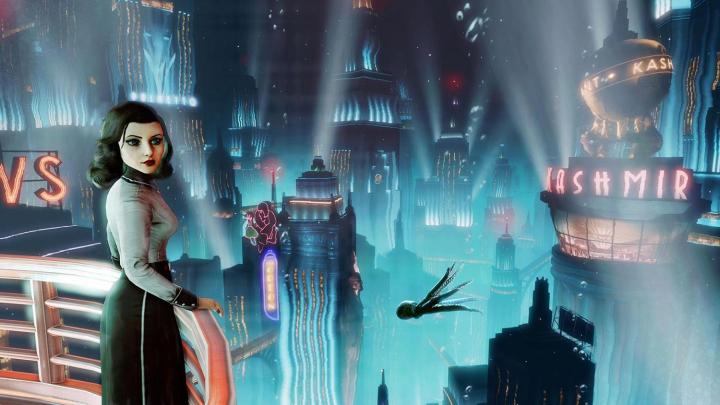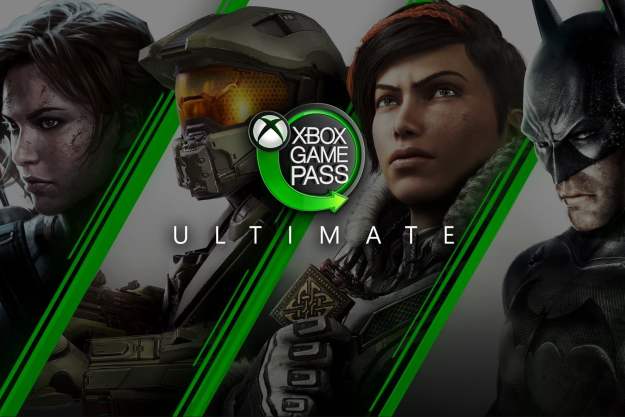
From the moment she walks into the office, you know she’s going to be trouble. The first part of BioShock Infinite’s Burial at Sea DLC plays with genre cliche from moment one, with private detective Booker DeWitt sitting at his office desk when Elizabeth strolls in. The wide-eyed innocence of the girl we met in Columbia is gone; in its place is an icy, all-business exterior. Liz has a job for Booker because, as she says, he doesn’t “look like the sort to turn down legitimate work.”
The whole scene unfolds from Booker’s first-person perspective. Shadows cast by tightly drawn blinds spill across the office, which is rendered in high-contrast black & white. Elizabeth strolls up to one window and gazes out of it. When she finally does turn around, an errant shaft of light draws attention to her eyes. It’s only when Booker lights Liz’s cigarette with a blazing fingertip that the film noir illusion is disrupted by a reminder that we’re still in BioShock‘s universe.
Film noir is a good reference point because it’s often about flaws that are deeply buried in characters.
Series creator Ken Levine, a fan of film noir, drew deeply from the genre to inform the style and story of Burial at Sea‘s first part. “You generally have a hero that’s deeply flawed, usually with something in his past and [feeling] quite ambivalent about what he’s doing. [Someone] who really, more or less, just wants to be left alone. He’s lost faith in himself,” he tells us. “Not every noir carries those themes, but Booker fits all of those things [in Infinite].”
Burial at Sea is an attempt to dive deeper into the darkness that Infinite established for Booker while capturing the visual language of a film genre marked by classics like The Big Sleep and Chinatown. The core game played with themes that are familiar to fans of these works, but the DLC builds on that with a stylistic presentation that pays homage. The high-contrast black & white opening scene speaks to that. Here’s Elizabeth, bringing trouble into already-troubled Booker’s life, and no good can come of it.
“The first scene could be from a Barbara Stanwyck film. We looked at a ton of reference materials,” Levine says of Elizabeth’s office encounter with Booker. Anyone familiar with film noir can instantly spot what’s going on here: Booker is the hard-boiled private dick and Elizabeth is the femme fatale. It’s both a delightful subversion of the father/daughter-like relationship established in Infinite and an effective nod toward the source of Levine’s inspiration for the DLC.

“Film noir is a good reference point because it’s often about flaws that are deeply buried in characters,” he says. “How do you make a character in a first-person game interesting? Generally you can deeply bury something in that person. If you look at all of the [BioShock] games, [each of the protagonists] have something deeply buried in them, whether it’s Jack or Booker or this version of Booker. Sometimes they know about it, sometimes they don’t.”
“Having mystery locked up inside a character is a very powerful thing for a first-person game because you don’t see the person. Merging that mystery with the person’s sense of themselves as a character is always interesting.”
Levine also welcomed the opportunity to re-frame Infinite‘s female lead in the context of the main game’s late revelations. The Elizabeth that Booker first meets in Columbia is a distant memory by the time she walks into his office in Rapture. She’s effectively gone from Infinite‘s Disney princess to Burial at Sea‘s femme fatale, and it’s a stunning transformation. Elizabeth is almost unrecognizable when we meet her in Rapture. Her face is pale and rigid, set tightly. There’s nothing warm or welcoming about her. She seems familiar, but this is clearly not the innocent young girl we were so driven to protect during our journey through Columbia.
“The reference for Liz’s face was a modern image but [her makeup was] done in the style of that period,” Levine says. “Her makeup treatment is very important. She’s got a completely white foundation on and really red lips. It’s quite different [from her] skin tone in Infinite. It’s the same face, the same bone structure, and it’s the same actor doing the motions, same actor doing the voice.”
He adds, “For us, it’s interesting to see how far you can take your character in a relatively short period of time.” Irrational Games’ history with BioShock certainly bears that point out. Both the original game and Infinite follow their main characters over what is ultimately a short stretch of time. And yet both games’ key characters are changed dramatically by the unfolding events, and not at all for the better.
They’re almost Greek, these stories of the character getting caught up in their fate, and just circling and circling the drain.
“I like the noir films that end in bad places,” Levine says. “They’re almost Greek, these stories of the character getting caught up in their fate, and just circling and circling the drain. The harder they struggle, the worse it gets. [Characters] learning things about themselves, and learning terrible things about themselves, has just always been really interesting to me. It’s a structure that I like and I find it transfers well to games.”
Part two for Burial at Sea still lies ahead. It sounds like the stylistic focus on film noir may diminish or disappear entirely in the next chapter, but the series’ predominant themes aren’t going anywhere. The difference is in the main character: instead of Booker, players will take the role of Elizabeth. Anyone who played through the full story in Infinite knows a lot of truths about her, and the conclusion of Burial at Sea will focus on exploring those truths.
“Part two is very dark, but you go from Elizabeth being a complete opacity, as she is in this one, to completely transparent,” Levine says. “The whole goal of the next one is to understand why she did what she did [in Burial at Sea] on a deeper level. What that means to her and how she reacts to that and, most importantly, what does the world look and feel like to Elizabeth.”

“She doesn’t come from a background of [Booker’s] kind of darkness, and she has a different skillset,” Levine says. The goal is [to make part two] the Elizabeth simulator, emotionally and physically. How do we bring you inside her head and make you understand the perspective of somebody who saw all the doors, and what’s behind all the doors? Who has this omniscience? How do you convey that to a human? How do we contemplate it, and then how do we represent it?”
Editors' Recommendations
- BioShock Netflix film unites Logan and I Am Legend talent
- It’s official: There’s a new BioShock game in the works






